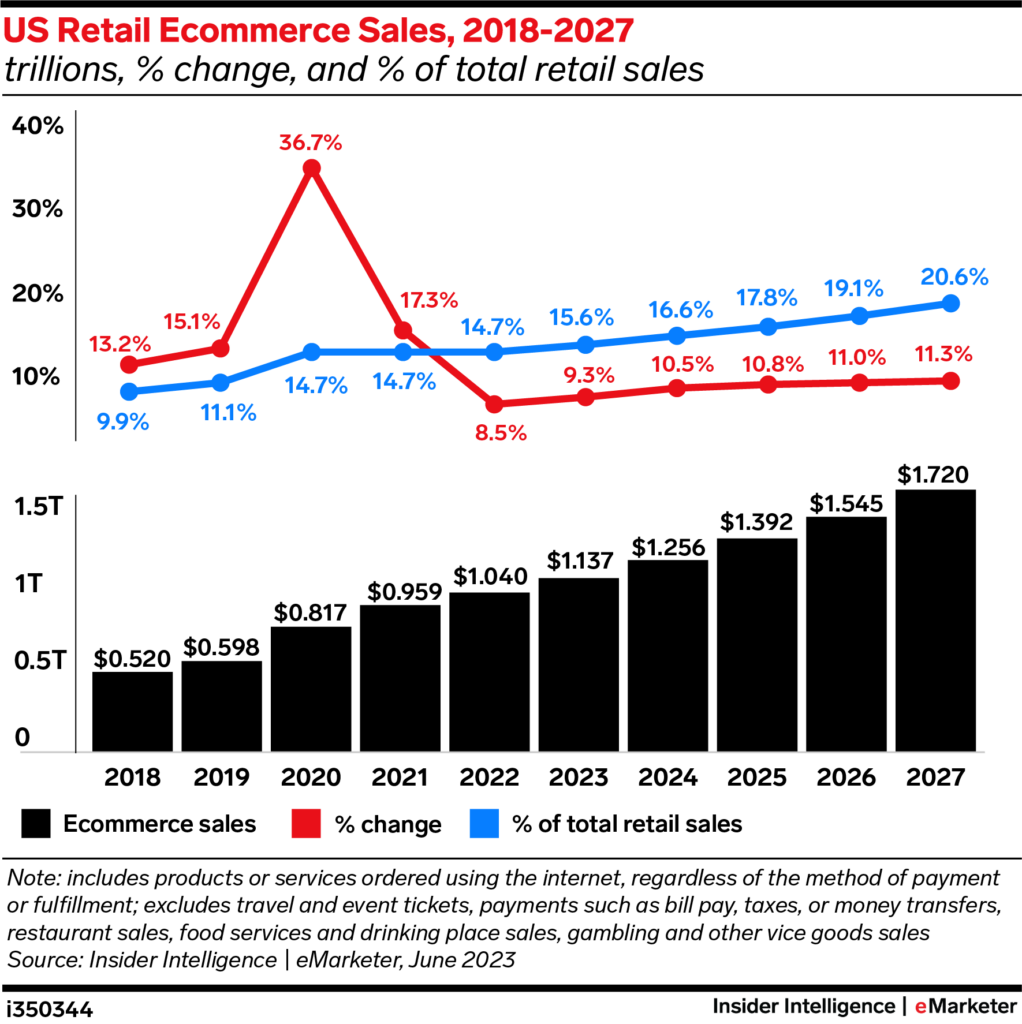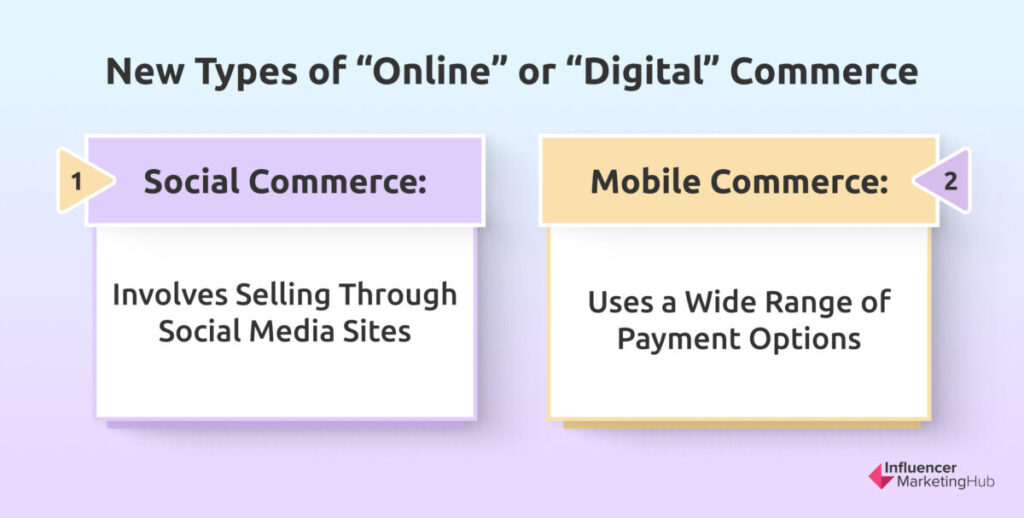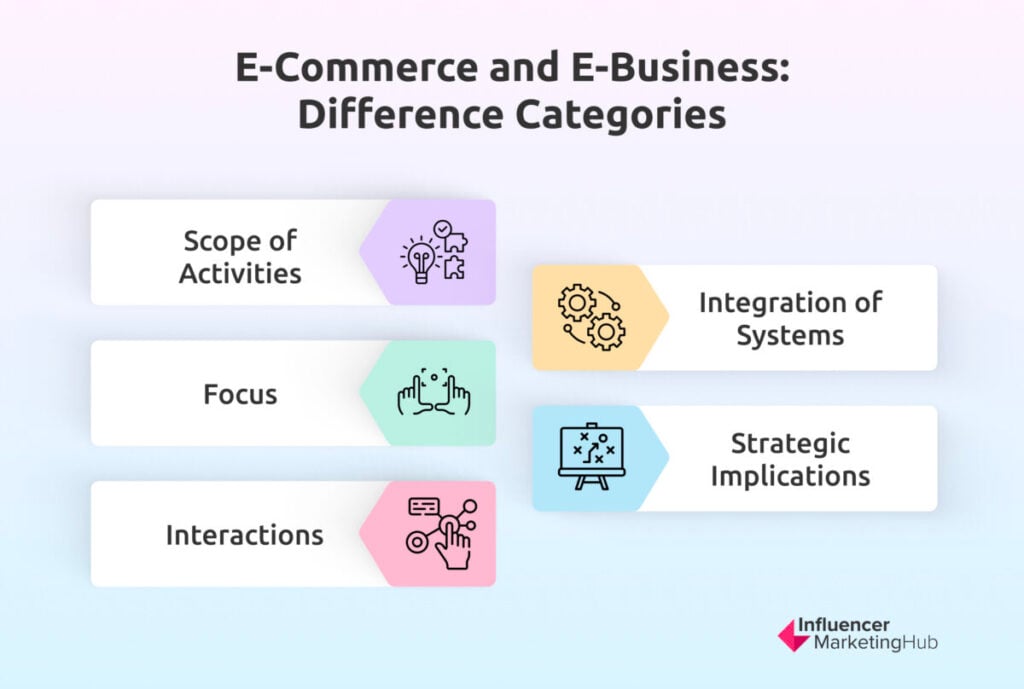E-commerce and e-business are often thought to be synonymous and used interchangeably. But these are two different concepts, and it’s important to understand the distinction. Knowing the difference will help you start a successful e-commerce business and take advantage of trends in today’s dynamic business landscape.
Simply put, e-commerce refers to any online transaction involving a monetary exchange, while e-business encompasses all digital components of running a business. E-commerce is a subset of the broader concept of e-business.
In this article, we’ll take a closer look at the differences between e-commerce and e-business and how knowing the difference can help you grow your business.
- E-Commerce in 2024: Growth Projections and Beyond Traditional Transactions
- The Broad Scope of E-Business: Moving Past E-Commerce to Efficient Workflows
- Understanding E-Commerce and E-Business: A Side-by-Side Comparison
- Key Differences Between E-Commerce and E-Business
- Choosing Between E-Commerce and E-Business: Aligning with Your Strategic Goals
- Importance of Understanding the Distinction
- Final Thoughts
- Frequently Asked Questions
E-Commerce in 2024: Growth Projections and Beyond Traditional Transactions
After its phenomenal growth in 2020, US e-commerce sales trends have stabilized to pre-pandemic levels and are expected to grow by 10.8% or $1.3 trillion in 2025. The same scenario holds true for other countries, notably China, where the e-commerce market is forecasted to become the biggest in the world.

E-commerce refers to online transactions that involve the electronic exchange of money for products or services. Shopping for clothes from an online store and paying for them using a credit card is considered e-commerce.
Ordering pizza from an app and paying for it in cash upon delivery is, technically, not an e-commerce transaction. The transaction has to be completed and paid online to be considered an e-commerce transaction.
Other activities considered to be part of e-commerce include online ticketing, online payments, online customer support, and online accounting software.
E-commerce can also be B2B (business-to-business) or B2C (business-to-consumer). In recent years, new forms of e-commerce have also emerged, notably C2C (consumer-to-consumer), C2B (consumer-to-business), B2A (business-to-administration), and C2A (consumer-to-administration).
- B2B E-Commerce: Two business entities transact with each other electronically. These are often large-scale and wholesale transactions.
- B2C E-Commerce: Companies sell directly to the end consumer of the product or service. This is the biggest and most common eCommerce type, including giant platforms like Amazon.
- C2C E-Commerce: Individuals sell directly to other individuals. This includes selling pre-loved items or starting a micro online business. Platforms like Facebook Marketplace enable this type of eCommerce.
- C2B E-Commerce: Individuals, like a consultant or freelancer, provide services to a business entity. This can also include individual consumers paid by a company to market their products.
- B2A E-Commerce: A business entity deals with a government regulator. Also called B2G (business-to-government), this includes transactions where a company complies with regulatory requirements like social security, permits, and others.
- C2A E-Commerce: A consumer transacts with a government entity completely online. This includes applying and paying for legal documents like your birth certificate and paying for government fees like taxes and fines.
In recent years, there have been newer types of “online” or “digital” commerce, namely social commerce and mobile commerce. Technically, both are not e-commerce.

Social commerce involves selling through social media sites like TikTok, Facebook, and Instagram. E-commerce, on the other hand, is an online shopping experience done via an online store or a dedicated brand app.
Mobile commerce, or m-commerce, uses a wide range of payment options, such as mobile wallets and contactless payments. E-commerce typically relies on credit cards and other traditional payment methods. M-commerce is considered a subcategory of e-commerce since it specifically involves purchasing and paying for goods and services using a mobile device.
The Broad Scope of E-Business: Moving Past E-Commerce to Efficient Workflows
E-business encompasses a broader scope than e-commerce. It refers to the integration of electronic technology into all aspects of business operations. This includes online buying and selling (e-commerce) and various other electronic interactions that facilitate the overall functioning of a business.
E-business extends its reach to cover areas like customer relationship management, supply chain management, customer education, email marketing, monetary business transactions, and online store setup.

Examples of e-business activities include:
- Nurturing leads and client relationships through email marketing
- Tracking inventory using inventory management software and using automated alerts to trigger low stock activities
- Using a content management system to manage workflow between a content developer, editor, and publisher
- Using job boards and recruitment portals to manage job applications and collect data about employees
In the absence of an electronic system, the above examples will be conducted by using and exchanging physical files. By digitizing these business functions, your business transforms into an e-business.
This leads to increased efficiency, reduced costs, and improved customer experiences. E-business solutions also enable companies to tailor their offerings to individual customer preferences through personalized marketing strategies, enhancing customer engagement and loyalty.
There are two categories of e-business:
- Pure Play: This e-business focuses on a specific product or service and has a purely electronic presence. Examples include a SaaS company invested in dominating its niche and without plans to venture into hardware. Others include websites that compare services such as hotels, flights, etc.
- Brick-and-click: This e-business has an online and offline presence and can alternate operations between the two. For example, a clothing company can have a physical store where customers can browse and try different styles and an online store where they can shop at their convenience.
Understanding E-Commerce and E-Business: A Side-by-Side Comparison
It’s common to get confused between e-commerce and e-business and use them interchangeably. But while they share similarities, they differ in terms of focus and scope.
E-commerce primarily revolves around online transactions. It refers to the buying and selling of goods and services over the Internet. Businesses set up online stores, showcase their products or services, and allow customers to make purchases electronically. The transactional nature of e-commerce is central to its definition. Popular e-commerce platforms like Amazon, eBay, and Shopify have revolutionized the way consumers shop and businesses sell.
E-business, on the other hand, encompasses a more comprehensive approach. It encompasses not only the buying and selling aspects but also the integration of electronic technology into various internal and external business processes. E-business involves electronic interactions with suppliers, partners, and customers, contributing to improved operational efficiency and strategic decision-making.
An e-business may not necessarily have an e-commerce operation, but an e-commerce operation will always involve an e-business component. For example, a marketing company relies on email marketing to nurture its leads and uses a content management system to handle its content production and distribution. However, it’s not engaged in the buying and selling of goods online and doesn’t have an e-commerce operation.
On the other hand, any e-commerce store will need various online electronic systems like an inventory system, a warehousing system, accounting software, and many others to thrive and scale its e-commerce operations.
Key Differences Between E-Commerce and E-Business
E-commerce | E-business |
Only involves online commercial transactions | Involves any business activity done electronically |
Narrow concept – a subset of e-business | Broad concept – the superset of e-commerce |
Transactions mainly use one website or app | Uses multiple websites, ERPs, CRMs, etc., to connect business processes |
Relies on the internet | Can use the internet, intranet, or extranet |
Involves external business processes | Involves external and internal business processes |
Widely used in the B2C context | Mostly appropriate in the B2B context |
While e-commerce and e-business share a digital foundation, they differ significantly in the following categories.

1. Scope of Activities
E-commerce predominantly deals with online commercial transactions. It is primarily concerned with the digital buying and selling of products and services. It centers on providing customers with a seamless and convenient platform for making purchases. While it can be used in any business context, it’s mostly prevalent in the business-to-consumer (B2C) model.
E-business, in contrast, covers a wider spectrum of activities that involve the integration of electronic technology into all aspects of business operations. These operations are not always commercial in nature, and e-commerce is only a small part of an e-business. It’s also mostly appropriate in the B2B context.
2. Focus
E-commerce places a strong emphasis on optimizing the online shopping experience for customers. User-friendly website design, intuitive navigation, secure payment gateways, and efficient checkout processes are all vital components of a successful e-commerce platform.
In e-business, while customer experience remains essential, the focus extends beyond just the transaction. E-business aims to enhance overall business processes, operational efficiency, and communication, which indirectly contribute to a better customer experience.
3. Interactions
E-commerce interactions are mainly transactional, involving the exchange of goods or services for money. The interactions are often short-term and revolve around product selection, payment, and delivery. These interactions can be carried out on a website or a branded app and always involve the internet. Since it’s external in nature, the other party is typically in another location, so an internet connection is required to complete the transaction.
In contrast, e-business interactions are more diverse and extend to various stakeholders, including suppliers, distributors, partners, and customers. E-business interactions facilitate communication, data sharing, and collaboration among various entities involved in the business ecosystem. These interactions can be carried out internally or externally and will be completed using one or several websites and business systems. It’s not always dependent on the internet; an intranet or extranet can be used to complete the transaction.
4. Integration of Systems
E-commerce systems are primarily concerned with setting up online storefronts, managing product listings, and facilitating secure online transactions. These systems can often be standalone or integrated with limited internal processes.
E-business requires a higher degree of system integration. It involves connecting various departments and functions within a company through shared software solutions. This integration allows for real-time data exchange, efficient collaboration, and better decision-making across the organization.
5. Strategic Implications
E-commerce strategies typically focus on marketing products online, optimizing conversion rates, and driving sales through online channels. The success of an e-commerce strategy is measured by metrics such as conversion rates, average order value, and website traffic.
E-business strategies, on the other hand, have broader strategic implications. They involve aligning technology with overall business goals, enhancing supply chain efficiency, improving customer relationships, and driving long-term business growth.
Choosing Between E-Commerce and E-Business: Aligning with Your Strategic Goals
For most businesses, it’s not really a choice of one or the other. It’s also not a question of which is better. Both e-commerce and e-business have specific and distinct business applications.
The decision to focus on either e-commerce or e-business depends on the nature of the business and its strategic goals.
For businesses primarily engaged in selling products online, investing in a robust e-commerce platform is essential. This involves creating user-friendly online stores, optimizing product listings, and providing secure payment gateways to enhance the customer shopping experience.
On the other hand, businesses seeking to transform their operations and interactions through technology should adopt an e-business approach. This requires implementing integrated software solutions that streamline various processes, from procurement and inventory management to customer support and marketing.
In most cases, adopting a robust e-commerce platform and transforming current processes to an e-business solution are the keys to becoming a modern organization that thrives in today’s digital era.
Importance of Understanding the Distinction
Understanding the distinction between e-commerce and e-business is vital for businesses that want to succeed in the digital landscape. This knowledge enables business owners and decision-makers to align their strategies with their objectives effectively.
By recognizing the broader implications of e-business, you can explore opportunities to streamline internal processes and enhance operational efficiency. By embracing a holistic e-business approach, you can strengthen relationships with partners and improve customer experiences.
Furthermore, understanding the potential and scope of e-commerce allows you to identify new avenues for growth and expansion, tailoring strategies to cater to the dynamic demands of the online consumer landscape.
Final Thoughts
While e-commerce and e-business are related concepts, they differ significantly in their scope, focus, and implications. E-commerce revolves around online transactions, while e-business encompasses a wider range of electronic interactions within and beyond buying and selling.
Businesses must evaluate their goals and operational needs to determine whether to prioritize e-commerce for streamlined online sales or adopt e-business strategies for comprehensive digital transformation. The choice between these approaches can make a significant difference in a company's success.
Understanding the nuances between e-commerce and e-business is a strategic imperative. This empowers you to adapt, innovate, and seize opportunities that will shape your success in the digital world.
Frequently Asked Questions
What is the difference between e-business and e-commerce?
Electronic commerce (e-commerce) focuses on the online buying and selling of goods and services, while electronic business (e-business) encompasses a broader range of electronic interactions, including internal processes, customer relationship management, and supply chain management.
E-business goes beyond transactions to integrate electronic technology into various aspects of business operations.
What is an example of e-business and e-commerce?
An example of e-commerce is an online clothing retailer selling its products through a website. Customers can browse the catalog, select items, and make purchases electronically.
An example of e-business is a company using an integrated software solution to manage its entire supply chain. This includes electronic communication with suppliers for inventory replenishment, tracking shipments electronically, and automating order fulfillment processes.
What are the benefits of e-commerce?
E-commerce offers several benefits for businesses:
- Global Reach: Businesses can reach a global audience without the limitations of physical location, expanding market reach and potential customer base.
- 24/7 Availability: Online stores operate around the clock, allowing customers to shop at their convenience, leading to increased sales and customer satisfaction.
- Reduced Overhead: E-commerce eliminates the need for physical storefronts, reducing costs associated with rent, utilities, and staffing.
- Personalized Customer Experience: E-commerce platforms can offer customized product recommendations based on customer behavior, enhancing user experience and sales.
- Convenient Transactions: Secure payment gateways provide customers with a safe and convenient way to make purchases, boosting trust in online transactions.
- Efficient Inventory Management: E-commerce systems allow for real-time tracking of inventory, reducing overstocking or understocking issues.
- Data-Driven Insights: E-commerce platforms generate valuable data on customer behavior, which businesses can analyze to optimize their offerings and strategies.
Overall, e-commerce empowers businesses with greater flexibility, efficiency, and access to a broader market, contributing to improved profitability and growth.
What is the future of e-business?
The future of e-business holds exciting possibilities driven by technological advancements. Businesses will increasingly integrate AI and machine learning to enhance customer experiences through personalized interactions and efficient processes.
E-business will expand beyond online platforms, incorporating Internet of Things (IoT) devices for streamlined supply chains and real-time data exchange. Blockchain technology could improve security and transparency in transactions. Moreover, virtual and augmented reality may revolutionize product visualization and remote collaboration.
As e-business evolves, businesses must adapt to these trends to stay competitive and meet ever-changing consumer expectations.


